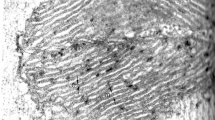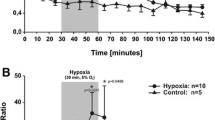Summary
Measurement of cardiac glucose oxidation (as a percentage of CO2 production) was made using the technique of infusion of14C-d-glucose, together with measurement of14CO2 and total CO2 produced by the myocardium. The measurements were made in 16 dogs under chloralose anaesthesia, before and after an i.v. injection of S-4-hydroxyphenylglycine (16.7 mg·kg−1, Oxfenicine: Pfizer). In one group of dogs circulating free-fatty-acid (FFA) levels were raised by infusion of intralipid heparin; in the other, circulating lactate was increased by infusion of 5 MNa-lactate (pH 7.0). In the last group of dogs the action of the drug was studied in cardiac denervated dogs.
In the dogs with normal circulating substrate levels, Oxfenicine increased the glucose oxidation from 17.3 to 39.9% of total substrate oxidized. This was also the case in those dogs with high circulating FFA (9.0 to 32.3%). However, in dogs with high circulating lactate (over 5.0 mmol·l−1) the oxidation of glucose was relatively unaffected (2.0 to 7.1%). In cardiac denervated dogs, with a known inhibition of glycolysis. Oxfenicine increased glucose oxidation from 4.8 to 23.5%.
These results show that Oxfenicine is able to switch the heart from the oxidation of fat to glucose or lactate as fuel.
Zusammenfassung
Mit Hilfe der Technik der14C-d-Glucose-Infusion in Verbindung mit Messungen von14CO2 und der Gesamtproduktion von CO2 durch das Myokard wurden Messungen kardialer Glucoseoxidation (als Prozentsatz der CO2-Produktion) durchgeführt. Diese Messungen wurden bei 16 Hunden unter Chloralose-Narkose vor und nach i.v. Injektion von Oxfenicin durchgeführt. Bei einer Gruppe von Hunden wurde der Spiegel der zirkulierenden freien Fettsäuren (FFA) durch Infusion von Intralipid-Heparin gesteigert. Bei der anderen Gruppe wurde der Laktatspiegel durch 5 M Na-Laktat-Infusion (pH 7,0) gesteigert. In der letzten Versuchstiergruppe wurde die Wirkung der Substanz bei Hunden mit denervierten Herzen untersucht.
Bei Hunden mit normalen zirkulierenden Substratspiegeln steigerte Oxfenicin die Glucoseoxidation von 17,3 auf 39% der gesamten Substratoxidation. Dies war auch der Fall bei Hunden mit hohem zirkulierenden FFA (Steigerung von 9,0 auf 32,3%). Jedoch wurde die Oxidation von Glucose bei Hunden mit hohem zirkulierendem Laktat (über 5,0 mmol/l) relativ wenig beeinflußt (von 2,0 auf 7,1%). Bei Hunden mit denervierten Herzen und Hemmung der Glykolyse steigerte Oxfenicin die Glucoseoxidation von 4,8 auf 23,5%.
Diese Ergebnisse zeigen, daß Oxfenicin beim Herzen eine Umschaltung der Substratoxidation von Fettsäuren auf Glucose oder Laktat bewirken kann.
Similar content being viewed by others
References
Blackburn, K. J., R. A. Burges, D. G. Gardiner, M. Higgins, Morville, M. G. Page: Protection against experimental myocardial ischaemia by L-4-hydroxyphenylglycine, a new agent which alters myocardial metabolic balance in favour of carbohydrate utilization. Brit. J. Pharmacol.66, 443P–444P (1979).
Blackshear, R. J., P. A. H. Holloway, K. G. M. M. Alberti: The metabolic effects of sodium dichloroacetate in the starved rat. Biochem. J.142, 279–286 (1974).
van den Bos, G. C., A. J. Drake, M. I. M. Noble: The effect of carbon dioxide upon myocardial contractile performance, blood flow and oxygen consumption. J. Physiol.287, 149–161 (1979).
Dixon, W. J., A. M. Mood: The statistical sign test. J. Amer. Stat. Assoc.41, 557–566 (1946).
Drake, A. J., J. Stubbs, M. I. M. Noble: Dependence of myocardial blood flow and metabolism on cardiac innervation. Cardiovasc. Res.12, 69–80 (1978).
Drake, A. J., J. R. Haines, M. I. M. Noble: Preferential uptake of lactate by normal myocardium in dogs. Cardiovasc. Res.14, 65–72 (1980).
Drake, A. J., D. E. Papadoyannis, R. G. Butcher, J. Stubbs, M. I. M. Noble: Inhibition of glycolysis in the denervated dog heart. Circulat. Res.47, 338–345 (1980).
Evans, C. L.: The metabolism of cardiac muscle. Recent Adv. in Physiol., 6th ed., 157–215. Churchill (London 1939).
Higgins, A. J., M. Merville, R. A. Burgess, D. G. Gardiner, M. G. Page, K. J. Blackburn: Oxfenicine diverts rat muscle metabolism from fatty acid to carbohydrate oxidation and protects the ischaemic rat heart. Life Sci.27, 963–970 (1980).
Higgins, A. J., M. Merville, R. A. Burgess., K. J. Blackburn: Mechanism of action of oxfenicine on muscle metabolism. Biochem. Biophys. Res. Comm. (submitted) (1981).
Issekutz, B., H. I. Miller, K. Rodahl: Effect of lactic acid on free fatty acids and glucose oxidation in dogs. Amer. J. Physiol.209, 1137–1144 (1965).
Keul, J., E. Doll, H. Steim, V. Fleer, H. Reindell: Über den Stoffwechsel des menschlichen Herzens. III: Der oxydative Stoffwechsel des menschlichen Herzens unter verschiedenen Arbeitsbedingungen. Pflügers Arch.282, 43–53 (1965).
Little, J. R., M. Goto, J. J. Spitzer: Effects of ketones on metabolism of FFA by dog myocardium and skeletal muscle in vivo. Amer. J. Physiol.219, 1458–1463 (1970).
McGinty, A.: Studies on the coronary circulation. 1: Absorption of lactic acid by the heart muscle. Amer. J. Physiol.98, 244–254 (1931).
Margaria, R., P. Cerretelli, P. Aghemo, G. Sassi: Energy cost of running. J. Appl. Physiol.18, 367–370 (1963).
Mansour, T. E.: Phosphofructokinase. Curr. Top. Cell. Reg.5, 2–46 (1972).
Pearce, F. J., J. Forster, G. de Leeuw, J. R. Williamson, G. F. Tutwiler: Inhibition of fatty acid oxidation in normal and hypoxic perfused rat hearts by 2-tetradecyl glycidic acid. J. M. C. C.11, 893–915 (1979).
Riemersma, R. E., A. Holland, P. Owen, B. Lewis, L. H. Opie: The oxidation and subcellular distribution of14C-palmitate in acute myocardial infarction. Cardiol.56, 364–369 (1971/1972).
Rose, C. P., C. A. Goresky: Constraints on the uptake of labelled palmitate by the heart. Circulat. Res.41, 534–545 (1977).
Shepard, R. J., C. Allen, A. J. D. Benade, C. T. M. Davies, P. E. Di Prampero, R. Hedman, J. E. Merriman, K. Myhre, R. Simmons: The maximum oxygen intake. An international reference standard of cardio-respiratory fitness. Bull. W.H.O.38, 757–764 (1968).
Spitzer, J. J.: Effect of lactate infusion on canine myocardial free fatty acid metabolism, in vivo. Amer. J. Physiol.226, 213–217 (1974).
Snedecor, G. W., W. G. Cochran: Statistical Methods, Iowa State University Press (Ames. Iowa, 1973).
Tutwiler, G. F.: Hypoglycemic activity of alpha-bromopalmitate in rats. Experientia29, 1340–1341 (1973).
Tutwiler, G. F., J. Kirsch, R. J. Mohrbacher, W. Ho: Pharmacologic profile of methyl-2-tetradecyl-glycidate (McN 3716), an orally effective hypoglycemic agent. Metab. Clin. Exp.27, 1539–1556 (1978).
Author information
Authors and Affiliations
Rights and permissions
About this article
Cite this article
Drake-Holland, A.J., Passingham, J.E. The effect of Oxfenicine on cardiac carbohydrate metabolism in intact dogs. Basic Res Cardiol 78, 19–27 (1983). https://doi.org/10.1007/BF01923190
Received:
Issue Date:
DOI: https://doi.org/10.1007/BF01923190




